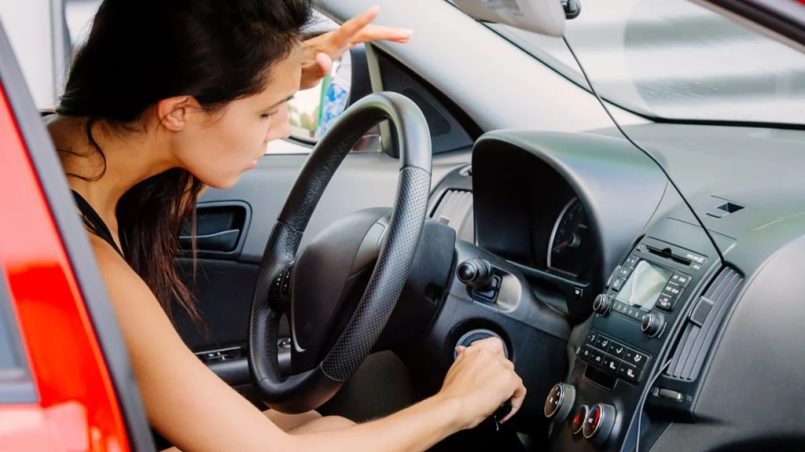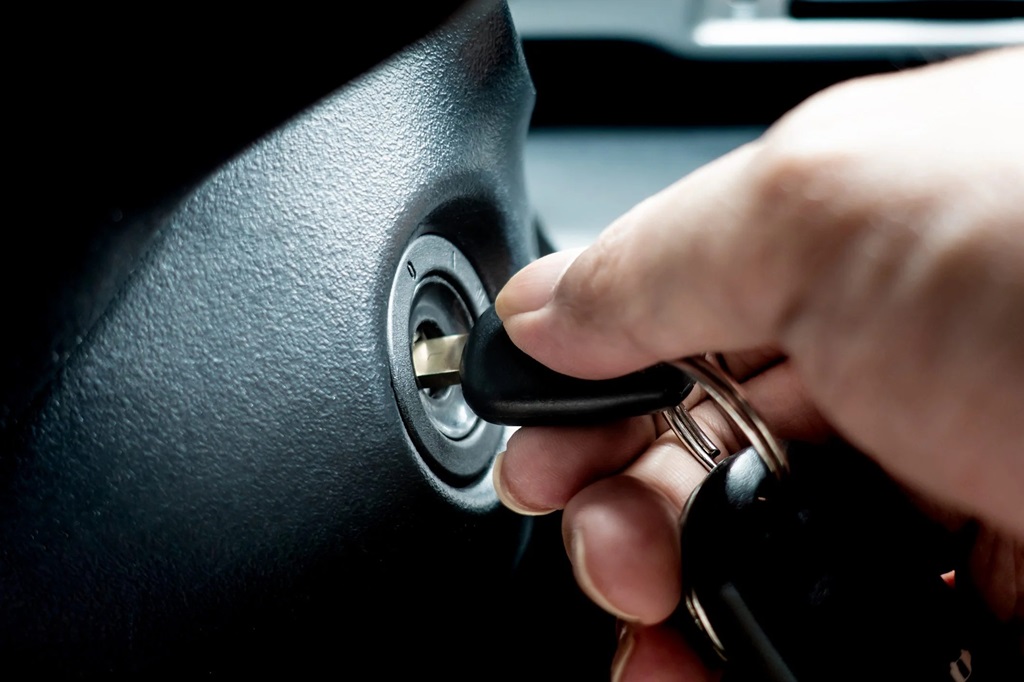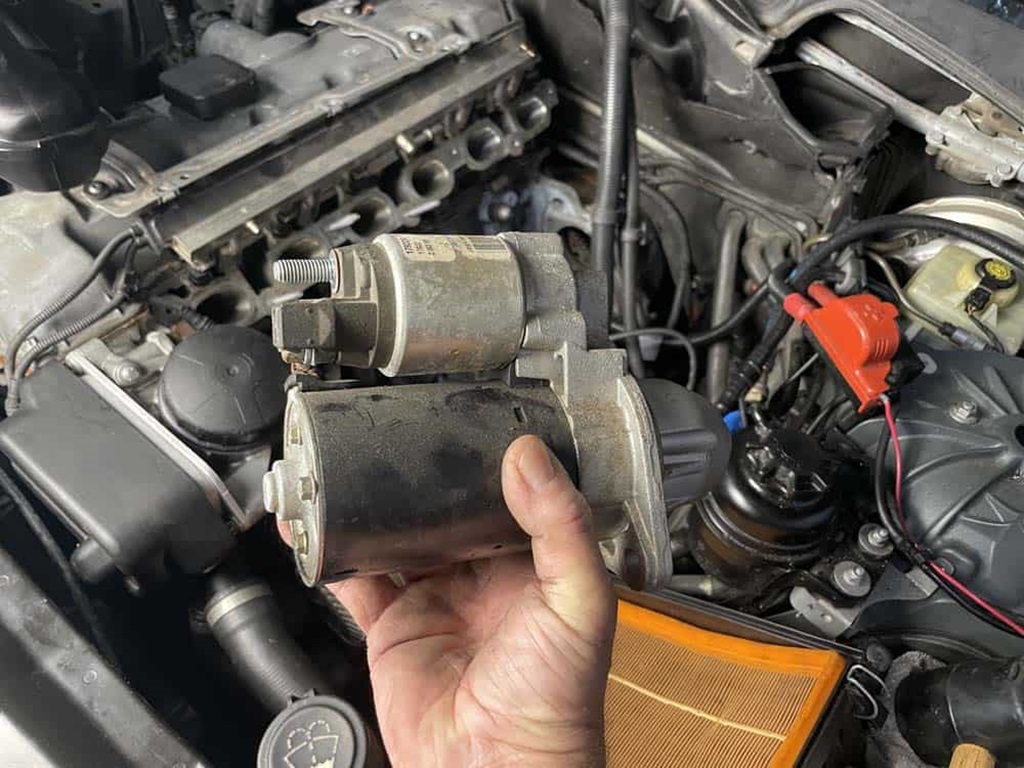Getting in your car, turning the key, and hearing nothing but a sad clicking sound or dead silence is never a good sign. It likely means your starter is on the fritz. But how to tell if starter is bad? And when do you know it’s time to replace the starter?
This article will cover the common symptoms of a bad starter, how to test your starter, and when you need a new one. We’ll also answer some frequently asked questions about diagnosing starter problems.
What Does the Starter Do?
Before jumping into the signs of a bad starter, let’s review what the starter actually does.
The starter is an electric motor that engages your engine’s flywheel, causing the engine to spin and start when you turn the ignition key. It delivers a high amount of torque for a short time to get the engine cranking. Once the engine starts and runs on its own power, the starter disengages.
When you turn the ignition key, a small electric current flows to the solenoid, which connects the battery power to the starter motor. The starter then turns the flywheel and cranks the engine. If the starter is worn out or defective, your engine won’t start.
Some of the key components of the starter system include:
- Starter motor – The electric motor that spins the engine.
- Solenoid – Engages the starter motor when current is applied.
- Ignition switch – Sends current to the solenoid when turned.
- Battery – Provides power to the starter.
- Flywheel – Spun by the starter to crank the engine.
Knowing the basics of how your starter works makes it easier to diagnose potential problems. Next, let’s look at the common signs your starter may be failing.
Symptoms of a Bad Starter
A failing or bad starter can manifest in a few different ways. Here are the most common signs your starter may be worn out:
1. Nothing Happens When You Turn the Key
The most obvious symptom of a bad starter is complete silence when you turn the ignition key. If you engage the starter but the engine doesn’t crank at all, the starter could be bad.
Potential causes include:
- Faulty or worn-out starter motor
- Corroded, loose, or broken wiring connections
- Bad ignition switch
- Low battery charge or dead battery
- Defective starter solenoid
If none of the electrical components are activating, there is likely an open circuit that needs to be diagnosed.
2. Clicking Sound But No Crank
Sometimes when you turn the key, you may hear a rapid clicking noise but the engine doesn’t crank. This clicking is caused by the solenoid repeatedly engaging and disengaging the starter motor.
This usually indicates there is power getting to the starter but the starter isn’t turning on and spinning the engine. Causes can include:
- The starter motor is seized up or stuck
- Bent armature on the starter motor
- Bad starter solenoid
- Low battery charge
- Poor electrical connections
If the battery is charged but the starter isn’t cranking, the starter may be bad and need replacing.
3. Intermittent Operation
Does your starter only work sometimes? Does it spin slowly or does nothing sometimes when you try to start? An intermittent starting problem can indicate a failing starter.
Some causes of intermittent starter operation include:
- Dirty or corroded battery cables
- Loose wiring connections
- Defective ignition switch
- Partial short circuit in the starter motor
- Binding or worn-out bearings in starter
In this case, the starter may work sometimes but completely fail to engage at other times. The inconsistent operation points to an underlying electrical issue.
4. Strange Noises When Cranking
Listen closely to the sounds your starter makes when you turn the key. Unusual noises can indicate starter problems. Here are some to listen for:
- Grinding noise – The starter gear may be damaged.
- A whining sound – Could mean bad bearings in the starter.
- A high-pitched screech – Signals an internal short circuit.
- Clicking sound – Points to a solenoid problem.
Any abnormal noises from the starter area when you engage it likely signify a malfunctioning component.
5. Engine Cranks Slowly
Normally, a good starter will spin the engine at 250 RPM or faster while cranking. If your engine cranks noticeably slower than normal, that’s a warning sign.
Causes of slow cranking include:
- Weak starter motor
- Low battery charge
- Short circuit in the armature
- Seized bearings
- Engine mechanical problems
Slow cranking means the starter motor lacks the power to spin the engine fast enough for ignition. This often results in a longer, labored cranking process before the engine finally starts.
6. The Starter Engages While the Engine is Running
In rare cases, you may notice the starter trying to engage even while the engine is already running. This can cause a shrieking or grinding noise from the starter motor itself.
This abnormal symptom indicates a problem with the starter solenoid or related wiring that is causing the starter motor to remain partially energized even after startup.
It’s usually not a problem with the starter itself, but improper solenoid operation engaging the starter when it shouldn’t. Get this inspected right away since it can damage the starter motor if left unchecked.
How to Test Your Starter
Hearing common starter problems is useful, but it’s also helpful to do some DIY diagnostic tests to confirm the starter is the culprit before replacing it. Let’s look at a few simple starter tests you can do yourself.
Battery Voltage Test
It’s always a good idea to start by testing the battery itself before testing the starter. Use a multimeter to check the battery voltage. It should be 12.4-12.6 volts with the ignition off. With the engine running, it should be 13.7-14.7 volts if the alternator is charging properly.
If the battery voltage is low, recharge the battery and test the starter again. All starter tests require a good battery.
Ignition Switch Test
Use a multimeter to check for power at the ignition switch when turned to Start. Place the red lead on the small wire at the S terminal and ground the black lead.
You should get 12 volts when turning the key to Start. No power indicates an ignition switch problem.
Solenoid Test
You can bypass the ignition switch to test the solenoid directly. Connect the red lead to the large wire on the starter solenoid and touch the black lead to the battery negative terminal.
When you make this connection, the solenoid should audibly click and engage the starter motor. No click means a bad solenoid.
Jump Start Test
Jump-starting the starter is an easy way to bypass all electrical components and test the starter directly.
Connect one jumper cable to the starter solenoid post and touch the other cable to the positive battery terminal. This energizes the starter manually. If it still doesn’t crank, the motor itself is likely bad.
Bench Testing
For a more thorough test, you can remove and bench-test the starter motor. This requires disconnecting and removing the starter from the vehicle. Then connect it to a power supply off the vehicle and power it directly to see if the motor turns.
While more time-consuming, bench testing can definitively tell you if the motor and components are functional outside of the vehicle.
By performing a few basic starter tests like these, you can isolate the cause before replacing anything. If all tests point to a bad starter, it’s time for a new one.
When to Replace a Starter
Here are some clear signs it’s time to replace your starter:
- The starter motor does not spin at all when activated.
- You hear clicking but no cranking when the key is turned.
- The starter turns very slowly and cranking takes longer than normal.
- You hear grinding or other abnormal noises from the starter.
- Starter engagement is very intermittent, works sometimes but not others.
- Bench testing shows the starter components are damaged or faulty.
- The starter gear teeth are badly worn or chipped.
- Electrical tests show power at the switch but not at the solenoid or motor.
If your diagnosis leads you to conclude the starter is bad, replacement is the only option. It’s not advised to rebuild starters yourself, as the brushes, armature, and internal components require specialized tools and skills. It’s best to simply install a new starter that comes pre-assembled and tested.
Signs You Can Repair vs. Replace
While most bad starter problems require a complete replacement, a minor issue can sometimes be fixed without a new starter:
Repairable:
- Loose battery cables or connections
- Low battery charge
- Corroded or oxidized wiring
- Starter mounting bolts are loose
- Ignition switch malfunction
Need Replacement:
- Burnt, worn-out motor windings
- Short circuit or open winding in the armature
- Seized, frozen, or damaged bearings
- Bent armature shaft
- Broken mounting brackets
- Gear teeth are broken or missing
- The solenoid clicks but the motor won’t turn
- Brushes excessively worn
Unless it’s a very minor electrical issue, any problem within the starter motor itself will require installing a new unit.
DIY Starter Replacement Tips
Here are some tips for tackling a DIY starter replacement:
- Use a repair manual for the exact process for your vehicle. Steps vary.
- Disconnect the negative battery cable before doing any work.
- Support the starter when removing the mounting bolts. It is heavy.
- Label wires and connections for proper re-installation.
- Clean the starter mating surfaces on the engine for good mounting.
- Make sure the starter engages cleanly with the flywheel.
- Reconnect the battery after all mounting bolts are tightened.
- Test the new starter before reconnecting other components.
With basic mechanical skills and proper caution, most DIYers can replace a starter motor themselves and save on shop labor costs. Just be sure to get an exact fit replacement designed for your specific vehicle.
Conclusion
A balky or non-functioning starter can leave you stranded with a vehicle that won’t start. But armed with the right information, you can diagnose starter problems on your own and determine if a replacement is required. Just be attentive to the common symptoms, like slow cranking or clicking with no start. Conduct basic voltage, switch, and motor tests to confirm the issue. If it’s clearly the starter at fault, don’t delay too long on getting a new one installed and getting back on the road.
FAQs
Does a bad starter still crank?
A starter that is going bad can sometimes still crank the engine, but the operation will be intermittent. You may notice slow or weak cranking at times. Typically if the starter is engaging the flywheel at all, it has some life left in it. But failure is imminent and replacement is needed soon.
What happens if a starter goes out while driving?
If the starter totally fails without warning while driving down the road, the engine will not stall or shut off. The starter is not needed while the engine is running. However, you would not be able to restart the engine if you shut it off. You would need to get the starter replaced to start the car again after turning it off.
Can a low battery cause starter problems?
Yes, a low or dead battery can mimic many of the symptoms of a bad starter, like slow cranking or just a clicking sound. Always fully charge and test the battery before concluding the starter itself has failed. Weak battery power is one of the most common reasons for starter problems.
How long does a starter last?
The average lifespan of a starter motor is 100,000 to 150,000 miles. But this can vary widely depending on the vehicle, climate, frequency of use, and other factors. Starters used in stop-and-go driving conditions tend to fail sooner. Getting the battery and connections checked regularly helps maximize starter life.
Does a starter drain the battery?
Starters do not drain the battery after the engine starts. The small current required to operate the solenoid switch comes from the ignition switch, not the battery. However, a current draw caused by a stuck solenoid can run down the battery over time while the vehicle sits. This will manifest as a dead battery overnight or after a few days.





